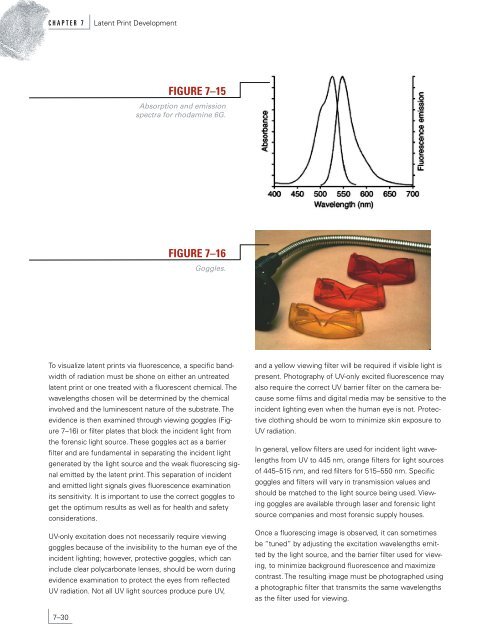Latent Print Development - National Criminal Justice Reference ...
Latent Print Development - National Criminal Justice Reference ...
Latent Print Development - National Criminal Justice Reference ...
Create successful ePaper yourself
Turn your PDF publications into a flip-book with our unique Google optimized e-Paper software.
C H A P T E R 7 <strong>Latent</strong> <strong>Print</strong> <strong>Development</strong><br />
FIGURE 7–15<br />
Absorption and emission<br />
spectra for rhodamine 6G.<br />
FIGURE 7–16<br />
Goggles.<br />
To visualize latent prints via fluorescence, a specific bandwidth<br />
of radiation must be shone on either an untreated<br />
latent print or one treated with a fluorescent chemical. The<br />
wavelengths chosen will be determined by the chemical<br />
involved and the luminescent nature of the substrate. The<br />
evidence is then examined through viewing goggles (Figure<br />
7–16) or filter plates that block the incident light from<br />
the forensic light source. These goggles act as a barrier<br />
filter and are fundamental in separating the incident light<br />
generated by the light source and the weak fluorescing signal<br />
emitted by the latent print. This separation of incident<br />
and emitted light signals gives fluorescence examination<br />
its sensitivity. It is important to use the correct goggles to<br />
get the optimum results as well as for health and safety<br />
considerations.<br />
UV-only excitation does not necessarily require viewing<br />
goggles because of the invisibility to the human eye of the<br />
incident lighting; however, protective goggles, which can<br />
include clear polycarbonate lenses, should be worn during<br />
evidence examination to protect the eyes from reflected<br />
UV radiation. Not all UV light sources produce pure UV,<br />
7–30<br />
and a yellow viewing filter will be required if visible light is<br />
present. Photography of UV-only excited fluorescence may<br />
also require the correct UV barrier filter on the camera because<br />
some films and digital media may be sensitive to the<br />
incident lighting even when the human eye is not. Protective<br />
clothing should be worn to minimize skin exposure to<br />
UV radiation.<br />
In general, yellow filters are used for incident light wavelengths<br />
from UV to 445 nm, orange filters for light sources<br />
of 445–515 nm, and red filters for 515–550 nm. Specific<br />
goggles and filters will vary in transmission values and<br />
should be matched to the light source being used. Viewing<br />
goggles are available through laser and forensic light<br />
source companies and most forensic supply houses.<br />
Once a fluorescing image is observed, it can sometimes<br />
be “tuned” by adjusting the excitation wavelengths emitted<br />
by the light source, and the barrier filter used for viewing,<br />
to minimize background fluorescence and maximize<br />
contrast. The resulting image must be photographed using<br />
a photographic filter that transmits the same wavelengths<br />
as the filter used for viewing.

















